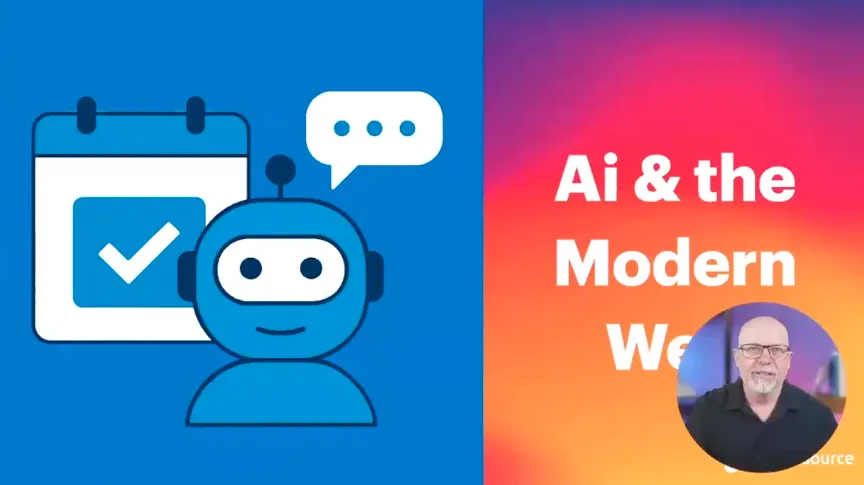How Population Size Shapes CMS Choices in Government

Table of Contents
Takeaway: Government CMS preferences evolve with population size, shifting from specialized proprietary solutions for smaller entities to enterprise-level, often open-source platforms for larger ones. This shift reflects the need for greater scalability, flexibility, and advanced features as government entities grow and face more complex digital demands.
NEED A CMS THAT CAN GROW WITH YOU? TALK TO OUR TEAM
CMS preferences by government size
Government website needs evolve with population size, driving distinct CMS preferences. In our recent study of government CMS usage trends, we’ve found that smaller entities such as small to midsized cities and counties tend to favor government-focused proprietary solutions, while larger entities tend to favor both open-source and proprietary enterprise-level systems.
We’re focusing on just the cities and counties because States don’t use government-specialized CMS platforms—or at least, we were not able to identify them.
Note: OpenCities is a Granicus product—we’re tracking it separately because Granicus doesn’t seem to be using it for all their government projects. Otherwise, it would have gotten identified by Wappalyzer.
CMS platform preferences of small counties and regions
Let’s start with counties.
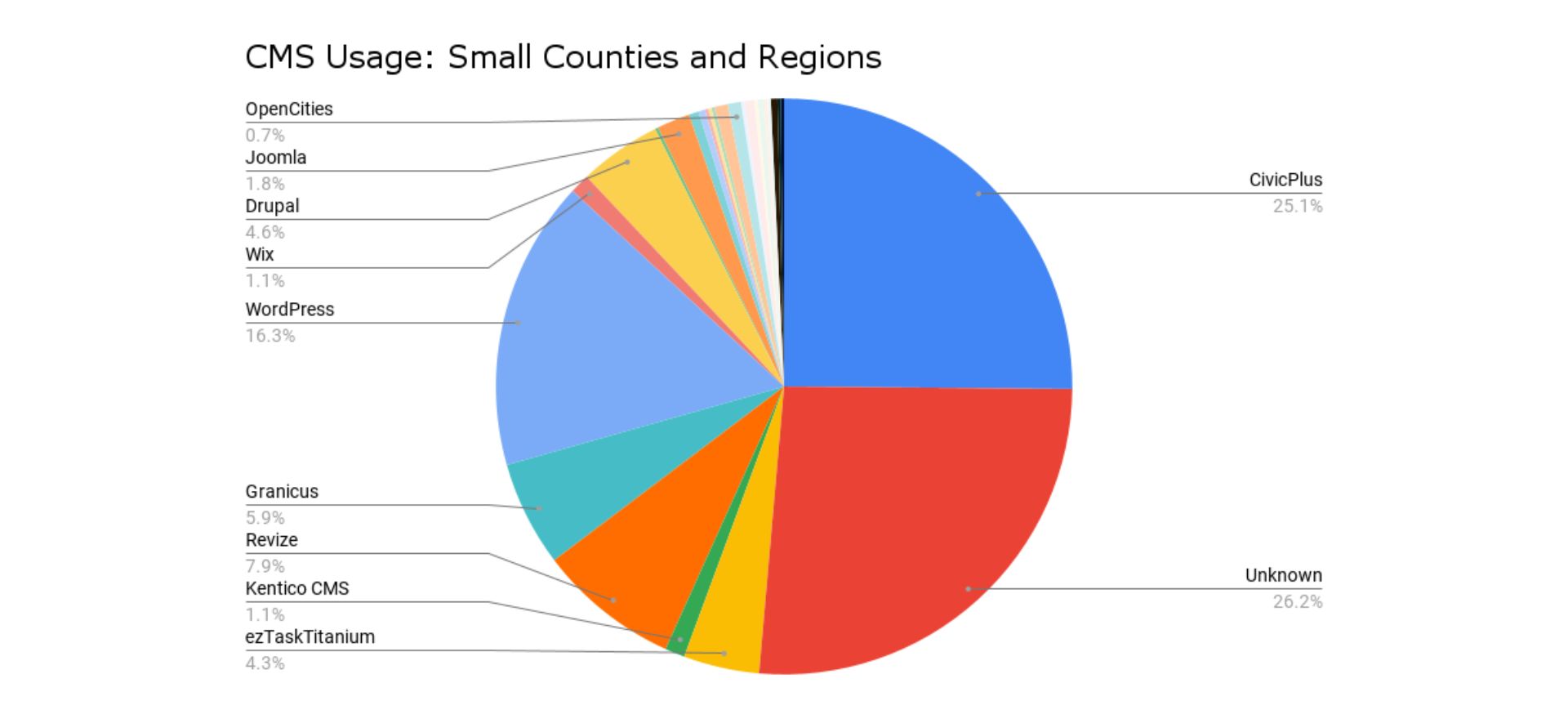
Looking at the overall CMS focus, we can see that small counties using a government-specialized CMS sit at 44.5% while non-government-focused CMS usage sits only at 29.2%. I am honestly interested to know what the unidentified CMSs are because it helps us get a clearer picture of where small counties (and generally the governments we’ve identified in the CMS usage study) spend their IT budget.
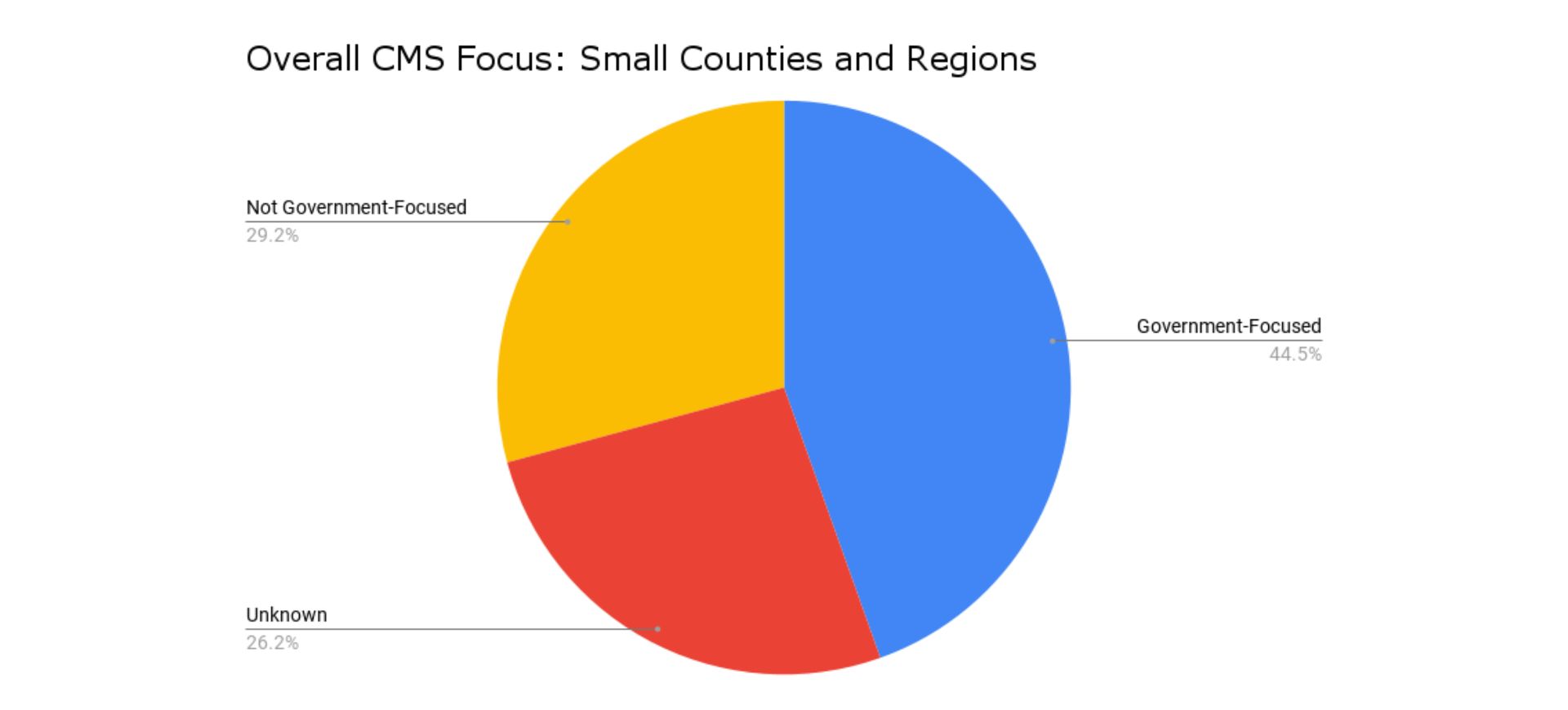
Narrowing it down to just the proprietary CMS systems, a whopping 92.7% of small counties make use of a government-specialized CMS. That’s huge.
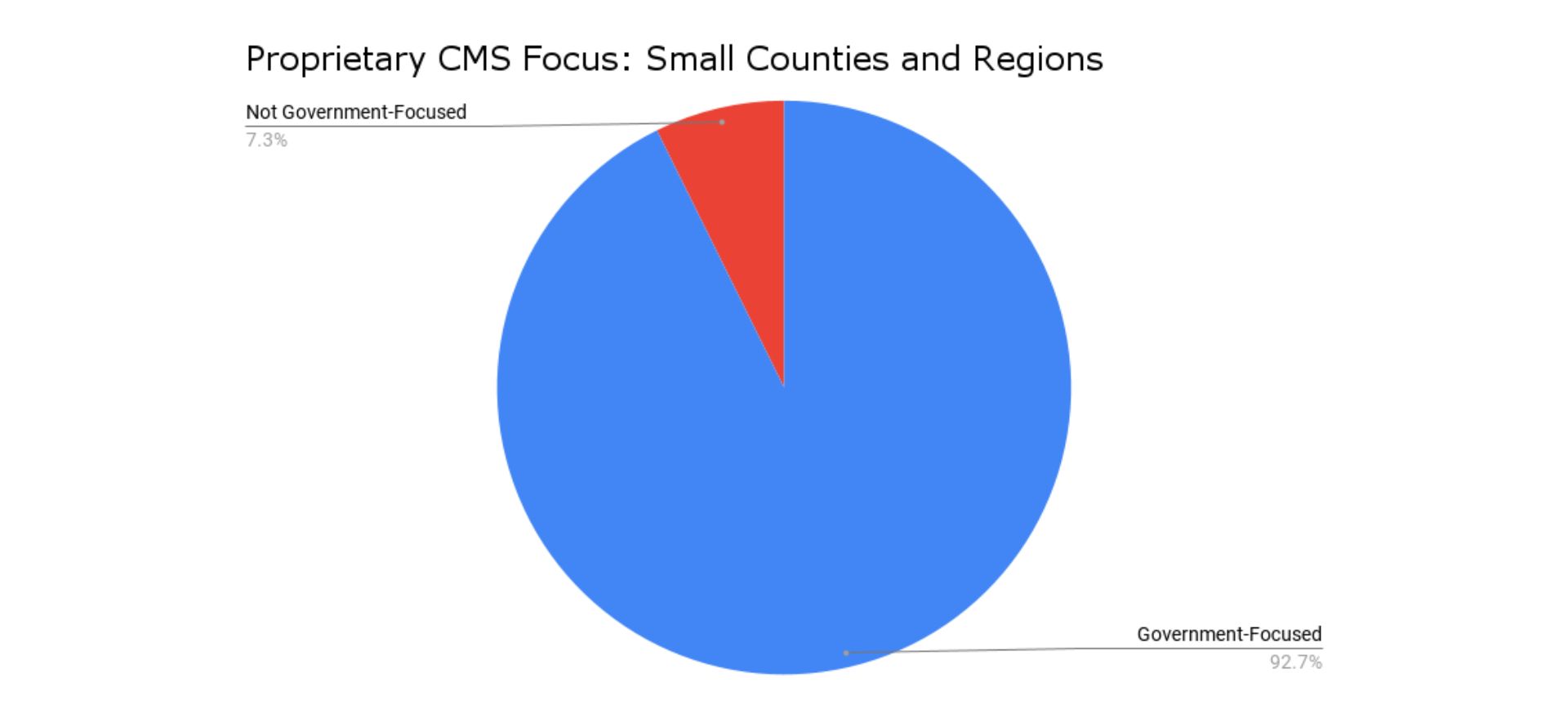
And yes, I’m not looking at the open-source CMS platforms here because none of them are government-focused.
For reference, here are the government-specialized CMS solutions:
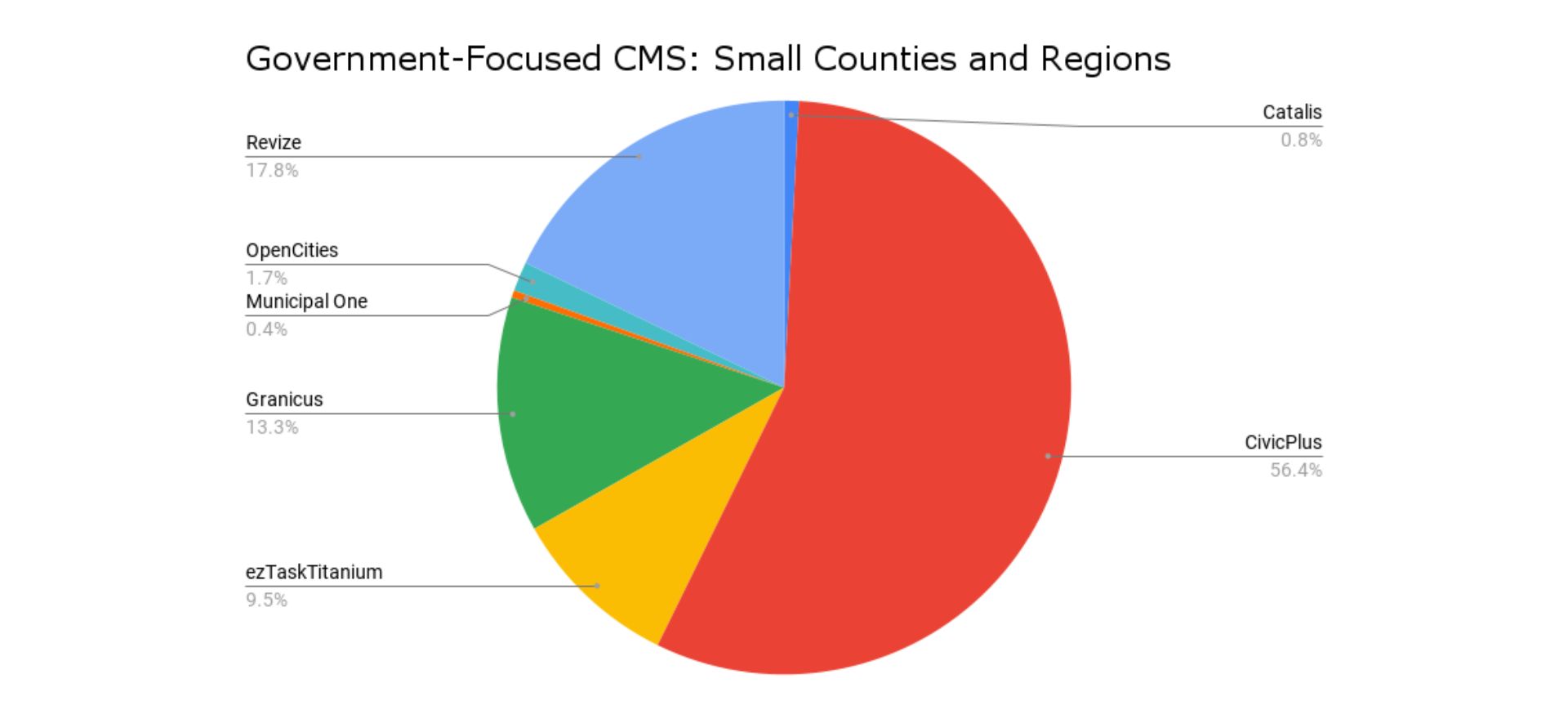
CivicPlus dominates the government-specialized market at a 56.4% share. The other notable government-focused proprietary solutions in this area are:
- Revize (17.8%)
- Granicus (13.3%)
- ezTaskTitanium (9.5%)
These platforms offer out-of-the-box features tailored to local government needs, simplifying website management for resource-constrained teams.
Read: Drupal vs Revize for Government: A Comprehensive Guide →
CMS platform preferences of mid-sized counties and regions
Now, let’s look at the mid-sized counties.
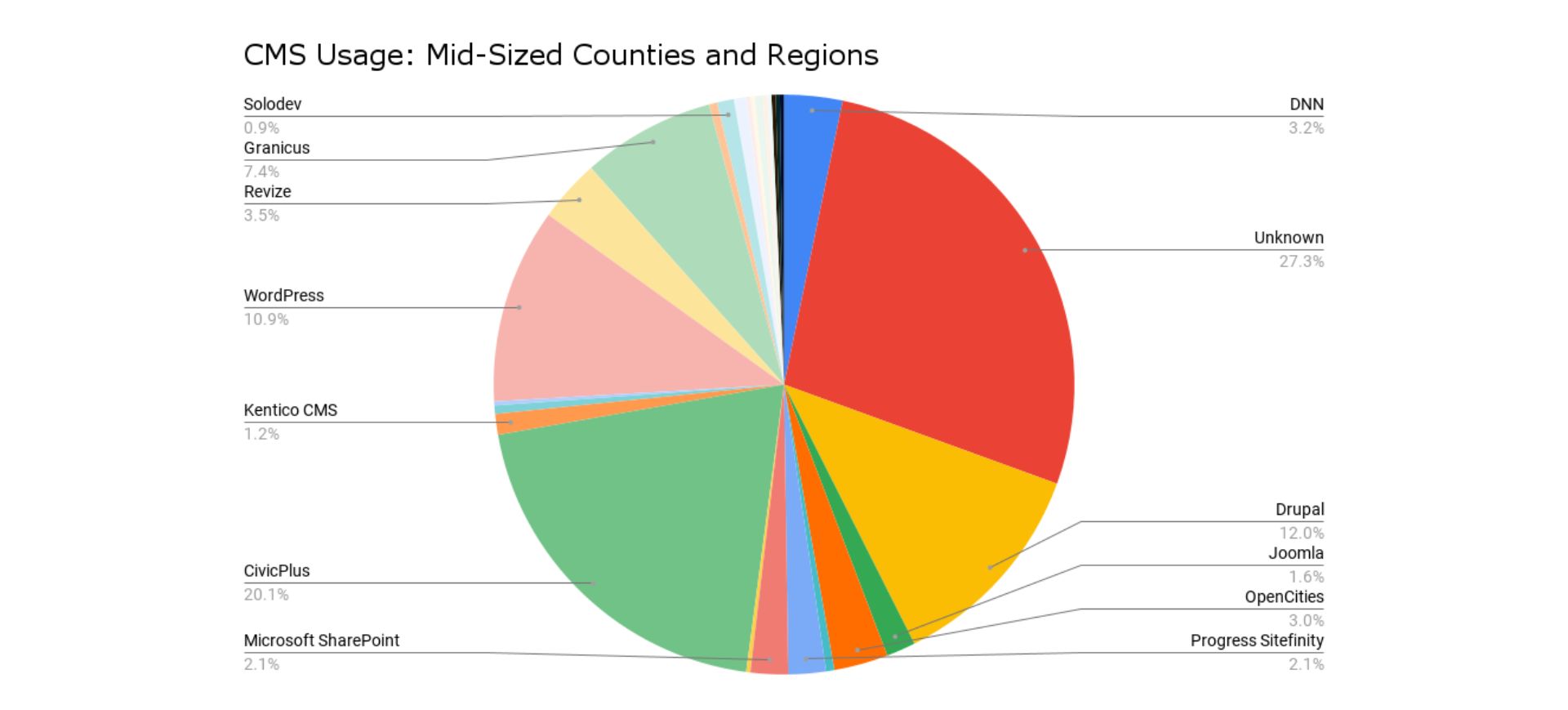
Checking their overall CMS focus, we can see that mid-sized counties using a government-specialized CMS have gone down to 35%, getting overtaken by non-government-focused CMS usage which is now at 37.7%. This is because of the increase in open-source CMS usage.
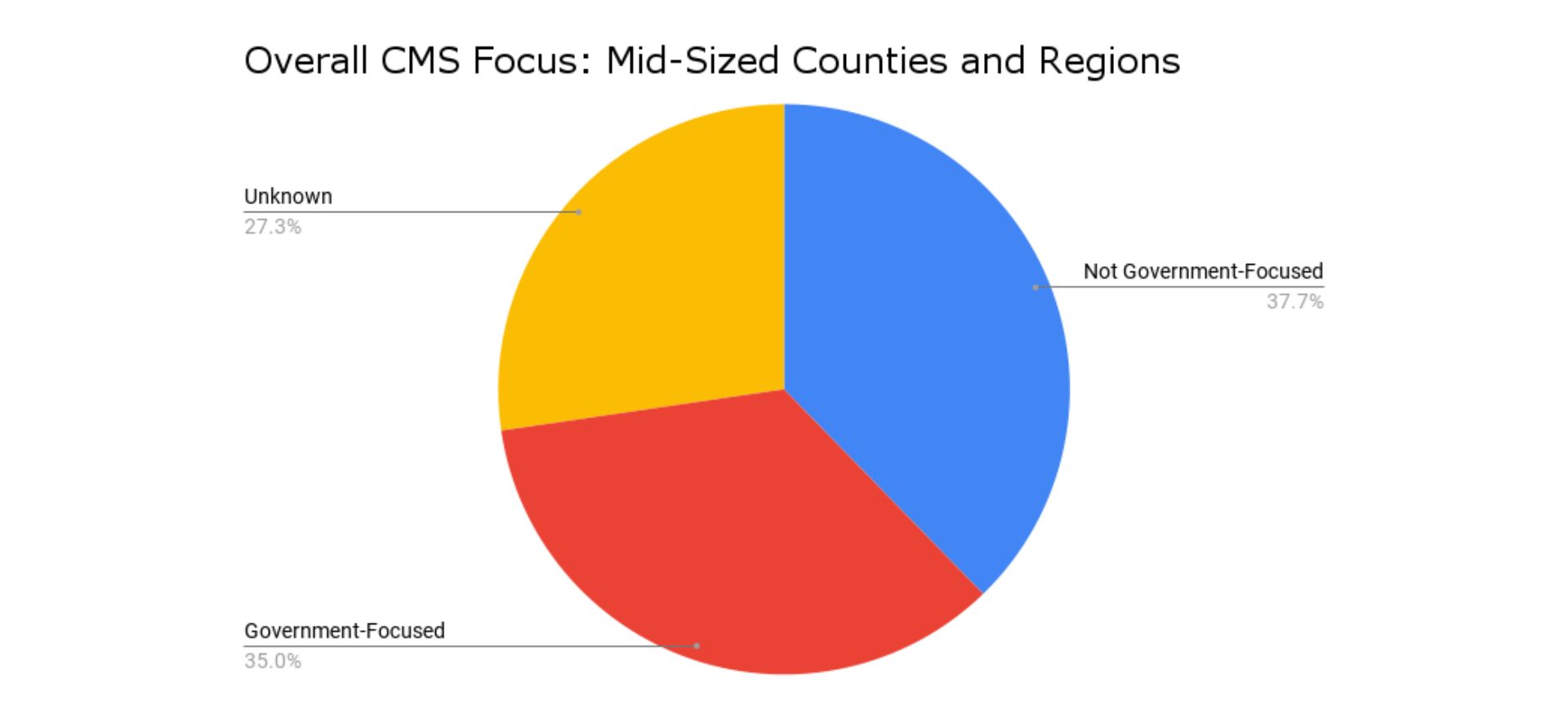
However, when we narrow this down further to see just the proprietary CMS systems, we do see a slight reduction in the use of government-specialized CMS platforms. We saw earlier that small counties are at a 92.7% adoption rate of government-focused proprietary systems. Mid-sized counties sit at 84.8%, giving us a difference of 7.9%.
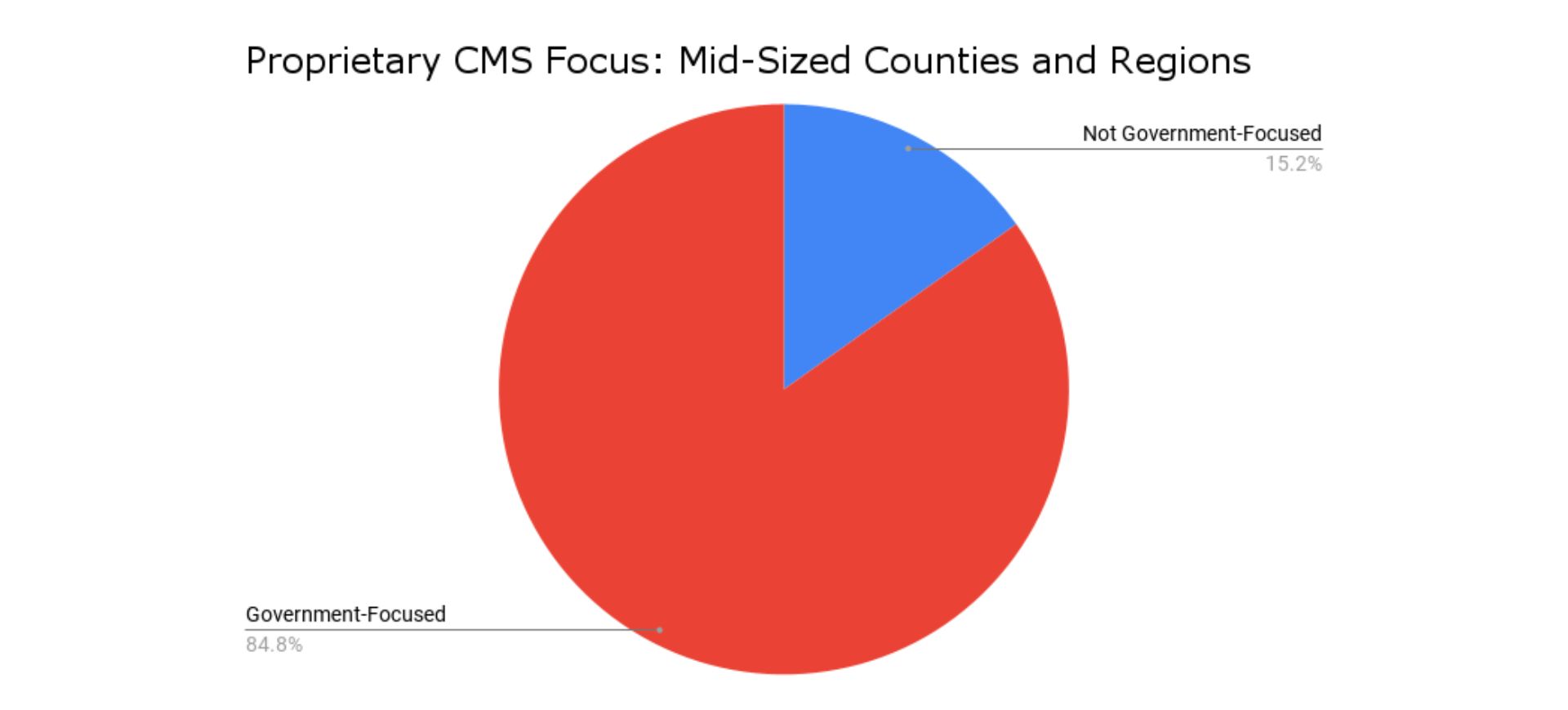
Looking now at the CMS platforms being adopted, CivicPlus once again dominates the market at 57.6%, with Granicus now following suit at 21.2% and Revize moving to third place at 9.9%.
Other notable observations:
- OpenCities has increased its share to 8.6%.
- ezTaskTitanium now sits at a measly 0.7%, getting overtaken by CivicLive (1.3%) which was not present in small counties.
- Catalis has disappeared.
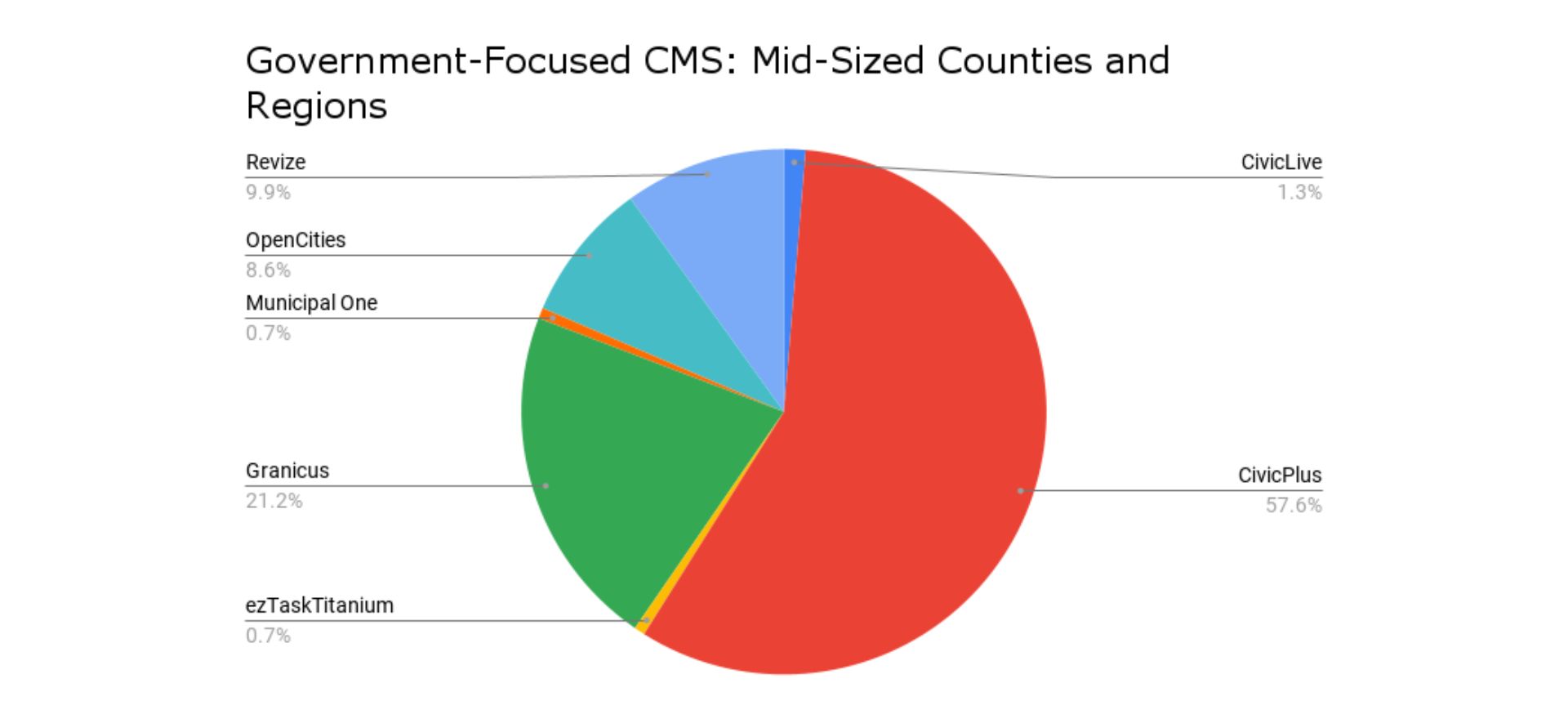
CMS platform preferences of large counties and regions
Let’s move on to the large counties.
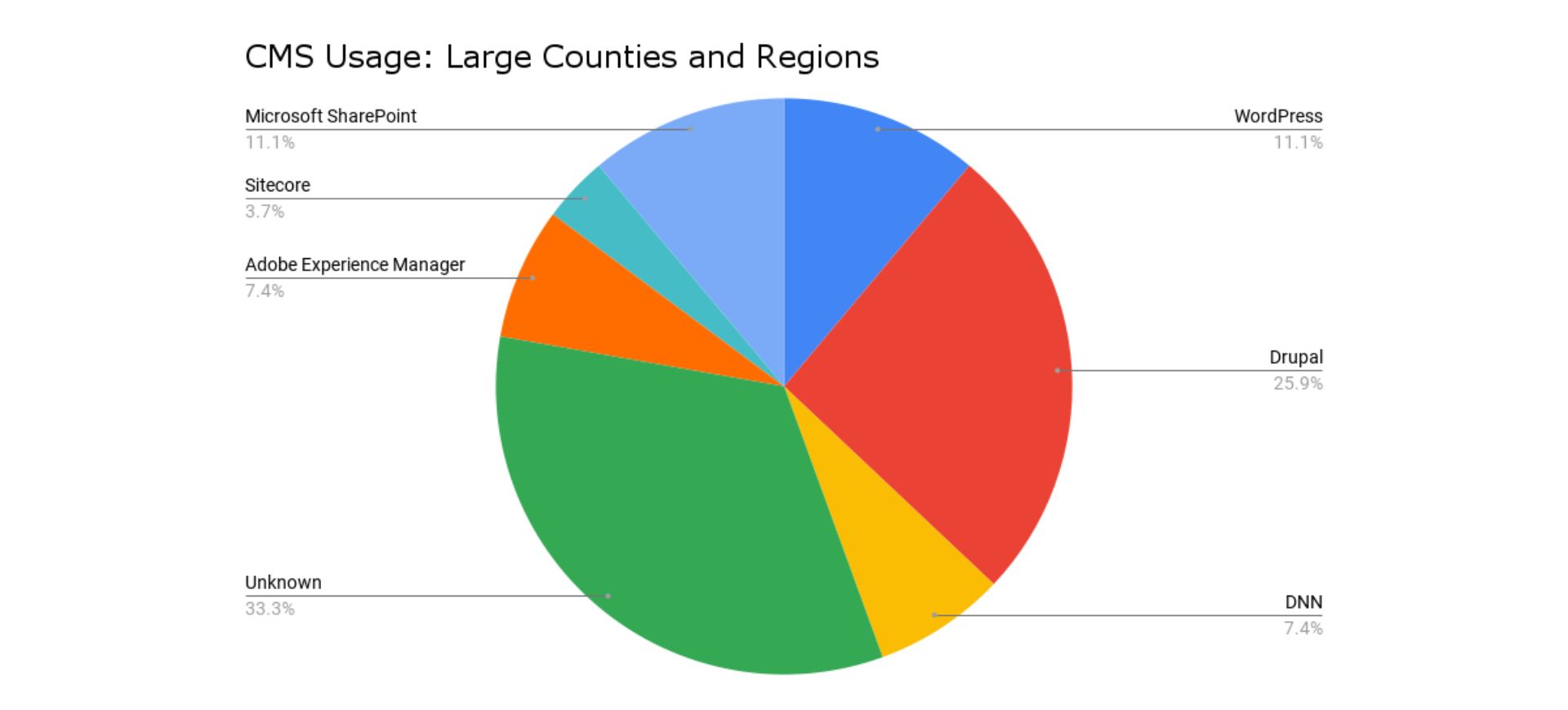
For the overall CMS focus, all the government-focused systems have disappeared. This is incredibly interesting considering we went from 84.8% adoption with mid-sized counties to 0% with large counties.
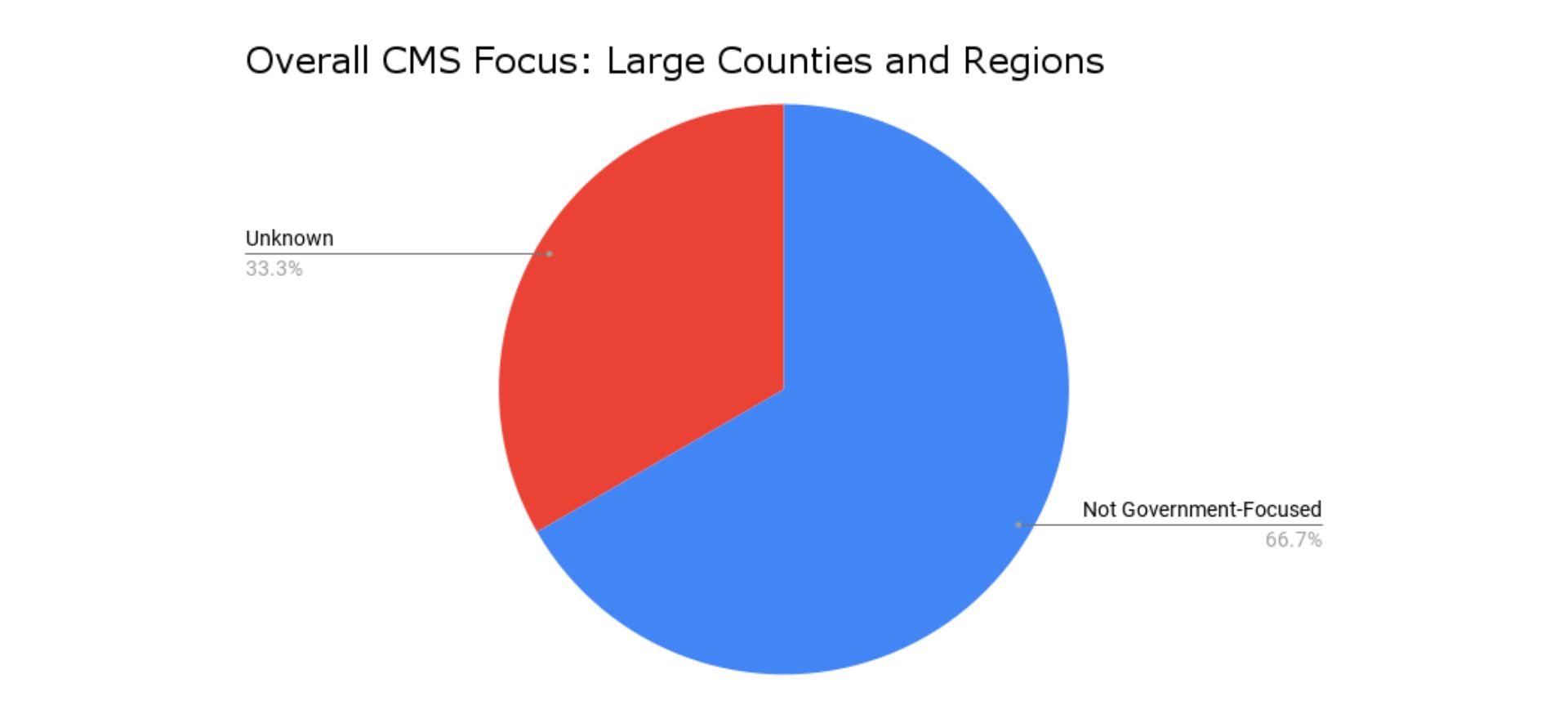
Let’s look at what they do favor.
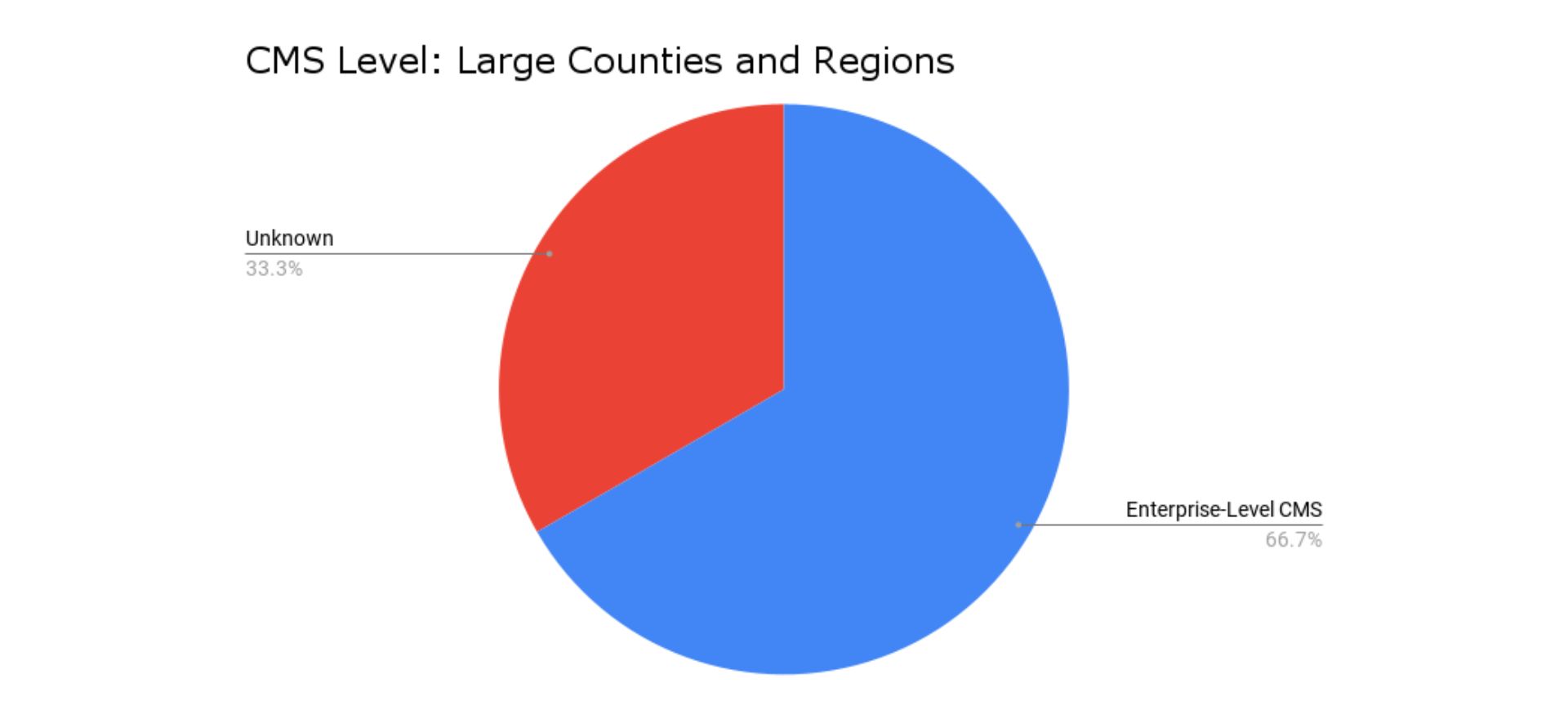
To be fair, Microsoft Sharepoint does have an Enterprise Edition. Unfortunately, I don’t know if the counties here are using just the Foundation or Standard levels. However, considering the population size being served by these websites, I think it’s not a reach to intuit that these counties could be using Enterprise.
There are also debates on whether WordPress sites are applicable to large-scale projects. The answer is yes, WordPress is enterprise-level—just because it started as a blogging platform doesn’t mean it stayed as one.
CMS platform preferences of small cities and towns
Time to discuss small cities. Just looking at the chart below, it’s fairly obvious what type of CMS dominates the preferences in this government type and population.
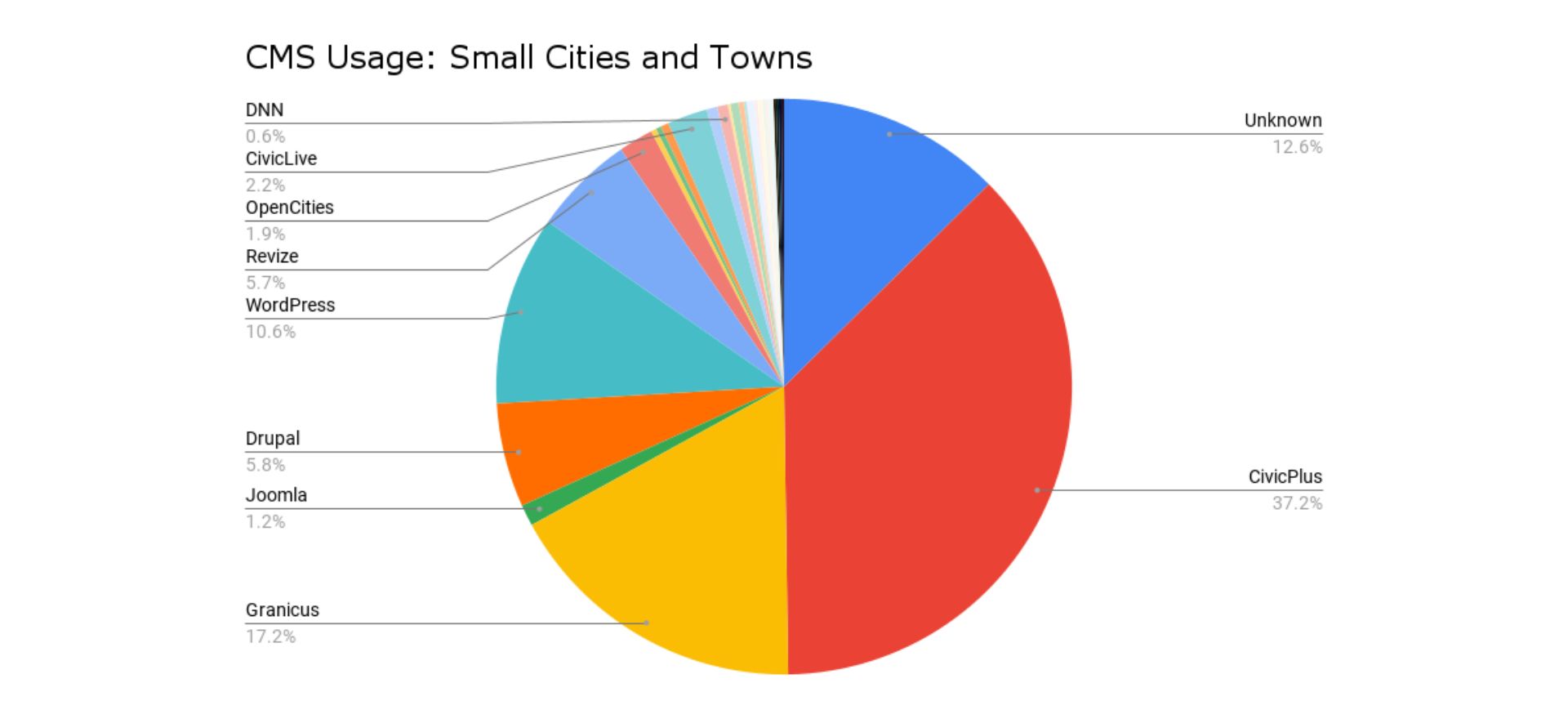
We see here again the trend of government-focused CMS systems dominating the market share at 65.1%, with non-government-focused CMS solutions sitting at 22.3%.
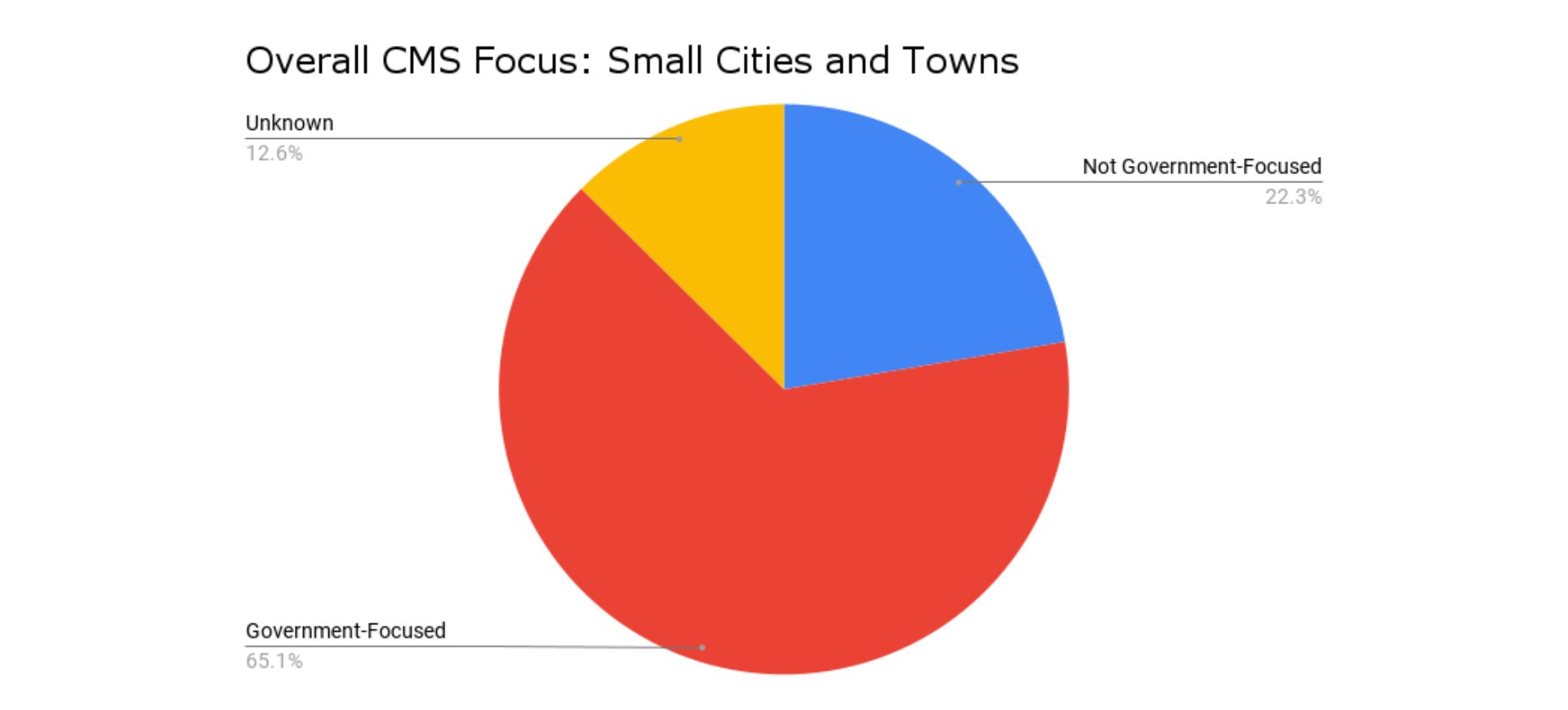
For the CMS focus, we see a tiny sliver of open-source government-focused CMS penetrating the market: GovStack.
This gives us a 0.5% open-source government-specialized CMS adoption for small cities, instead of the usual zero.
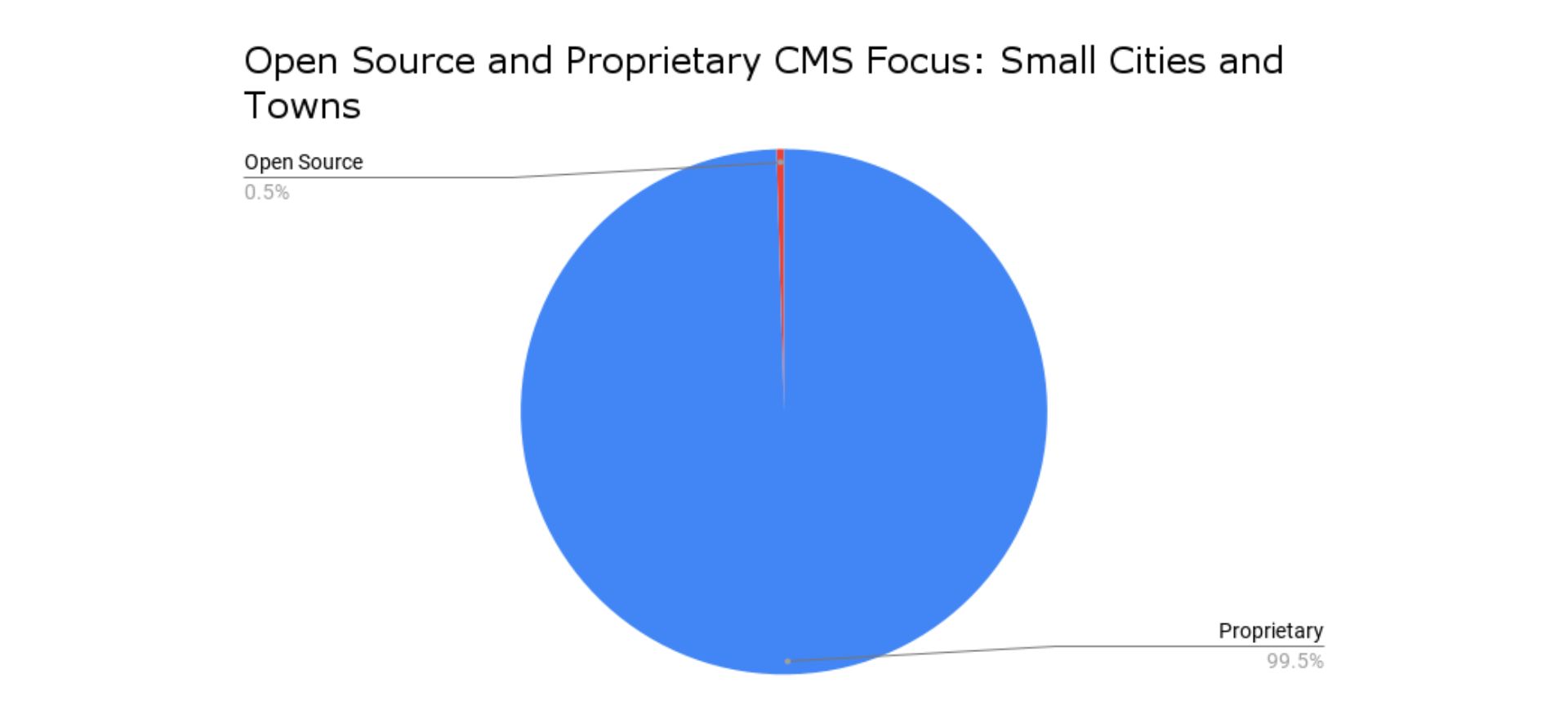
Now let’s look at the division of focus for the proprietary CMS platforms only. Here we can see a whopping 96.4% adoption of specialized CMS platforms—even larger than in small counties.
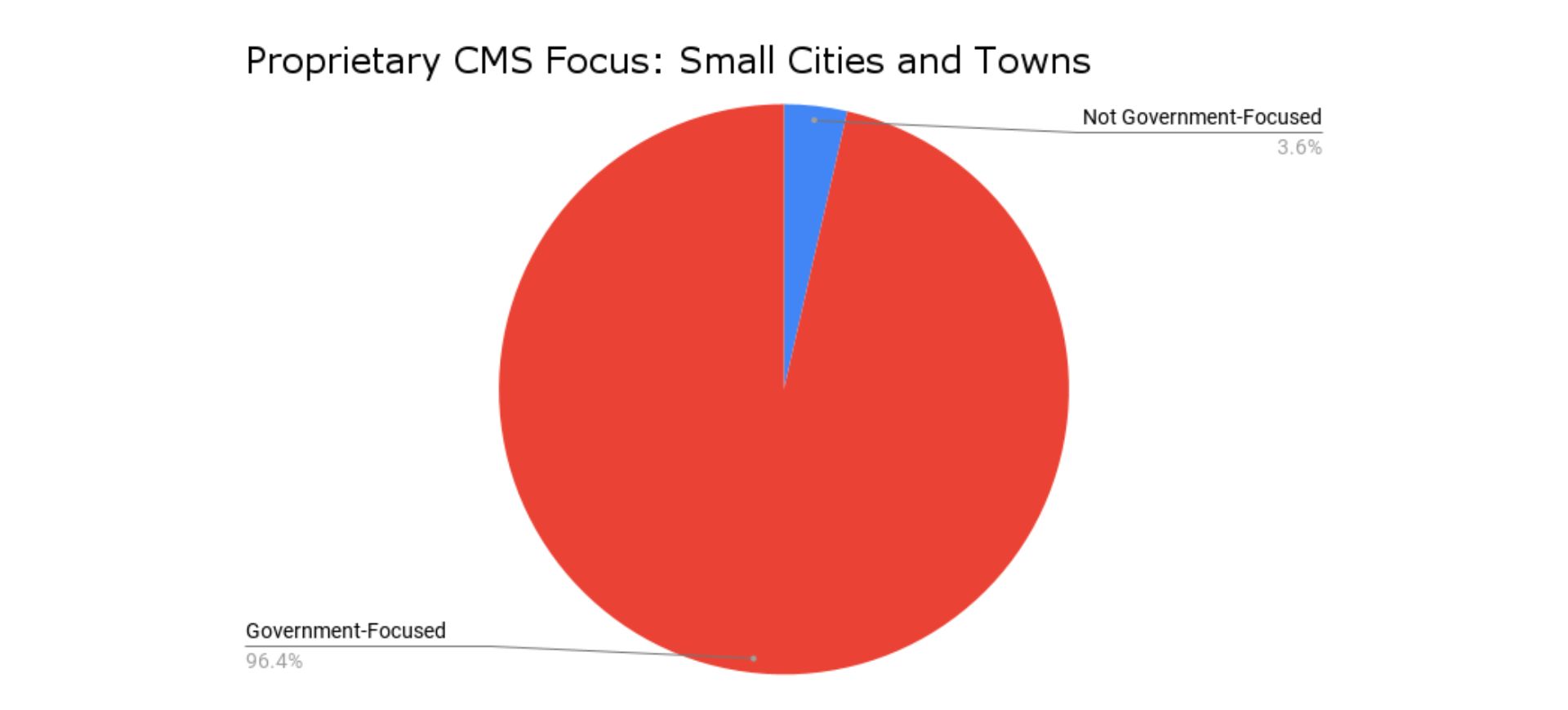
Breaking down the government-focused CMS solutions, we see CivicPlus in the lead once again at 57.1% with Granicus following suit at 26.5%.
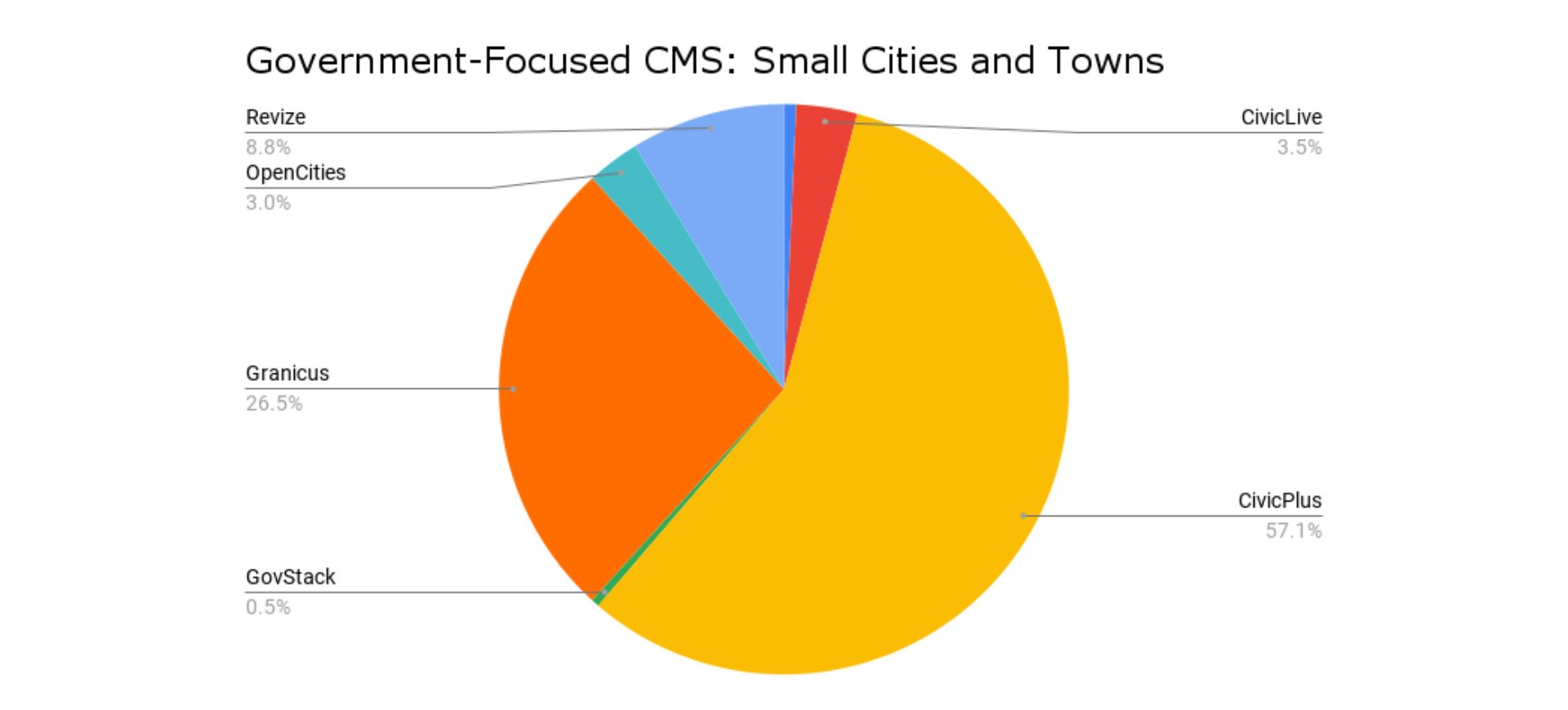
Other notable observations:
- Revize is once again in third place at 8.8%.
- CivicLive is represented here at 3.5%—mid-sized counties adopted them, but not small counties.
- OpenCities (3%) and Catalis (0.7%) are both present, similar to small counties.
CMS platform preferences of mid-sized cities and towns
Let’s move to the mid-sized cities.
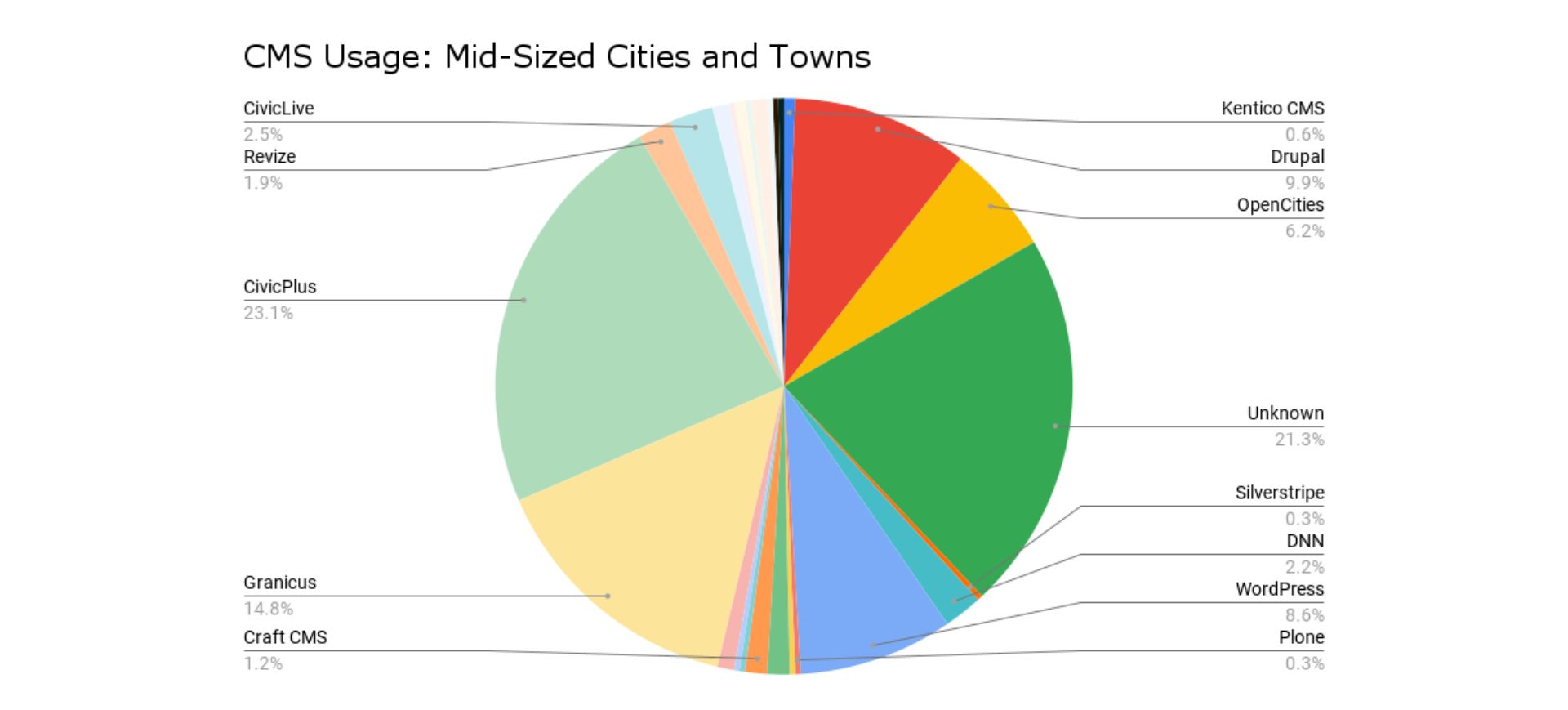
Here we see again a reduction in the adoption of government-specialized CMS platforms at 48.5%—a 19.3% difference from small cities.
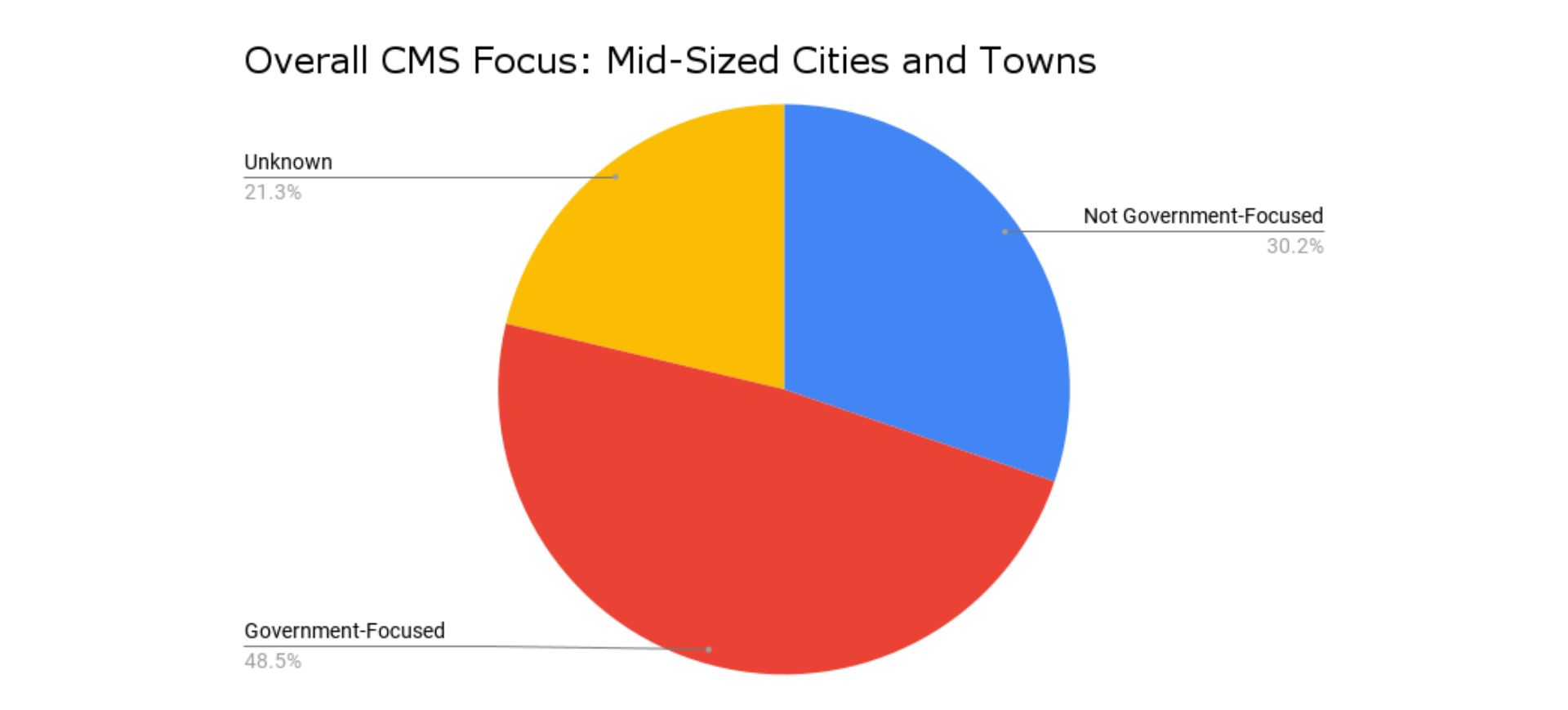
Continuing the trend, there is also a slightly higher adoption of non-government-focused proprietary systems at 8.2%—this was 3.6% in our small cities chart. This trend also follows what we’ve seen with the counties where the bigger the population size, the lower the adoption of proprietary systems with a government focus—and government-focused systems in general.
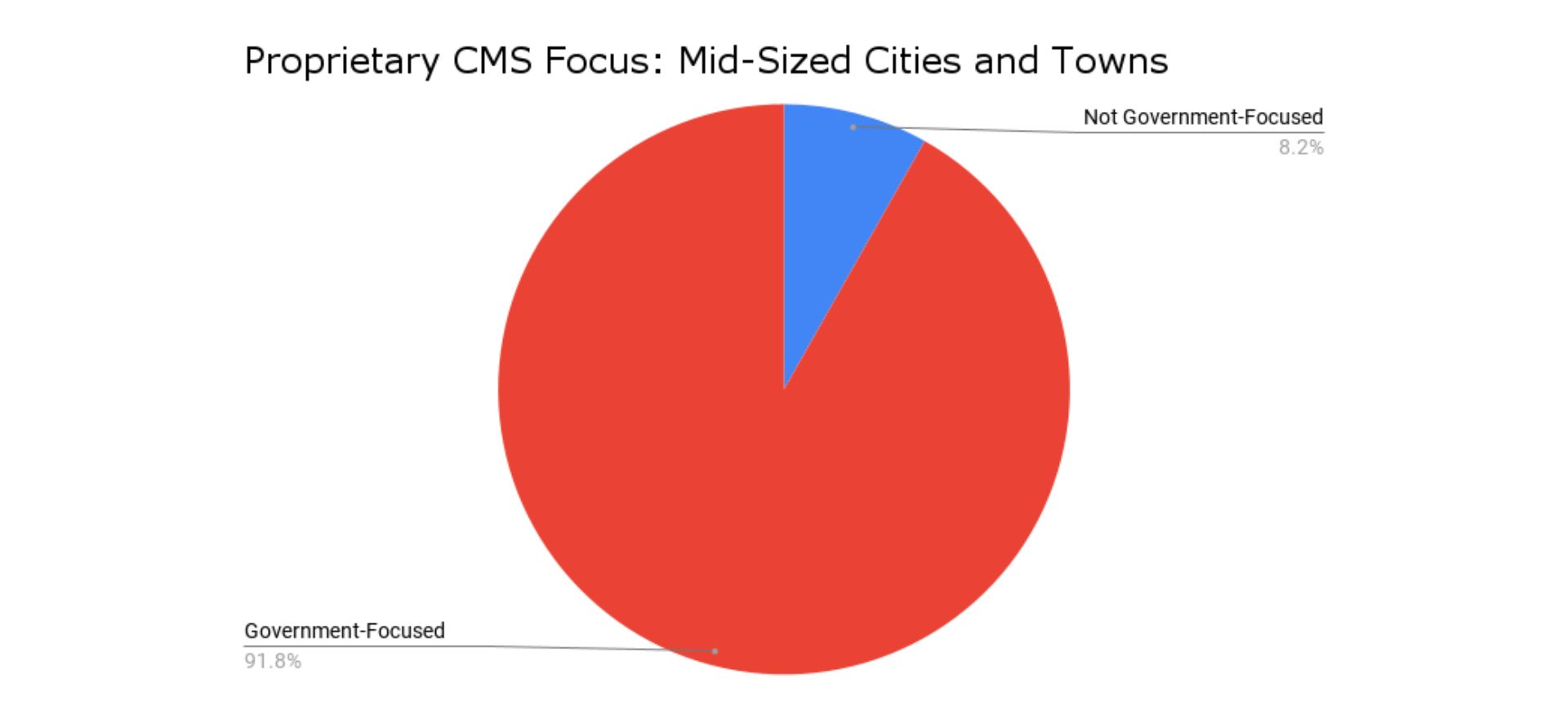
Now, let’s look at what comprises this group. CivicPlus (47.8%) and Granicus (30.6%) again hold the first two spots, while OpenCities (12.7%) holds the third place. It is notable here that GovStack and Catalis are both gone.
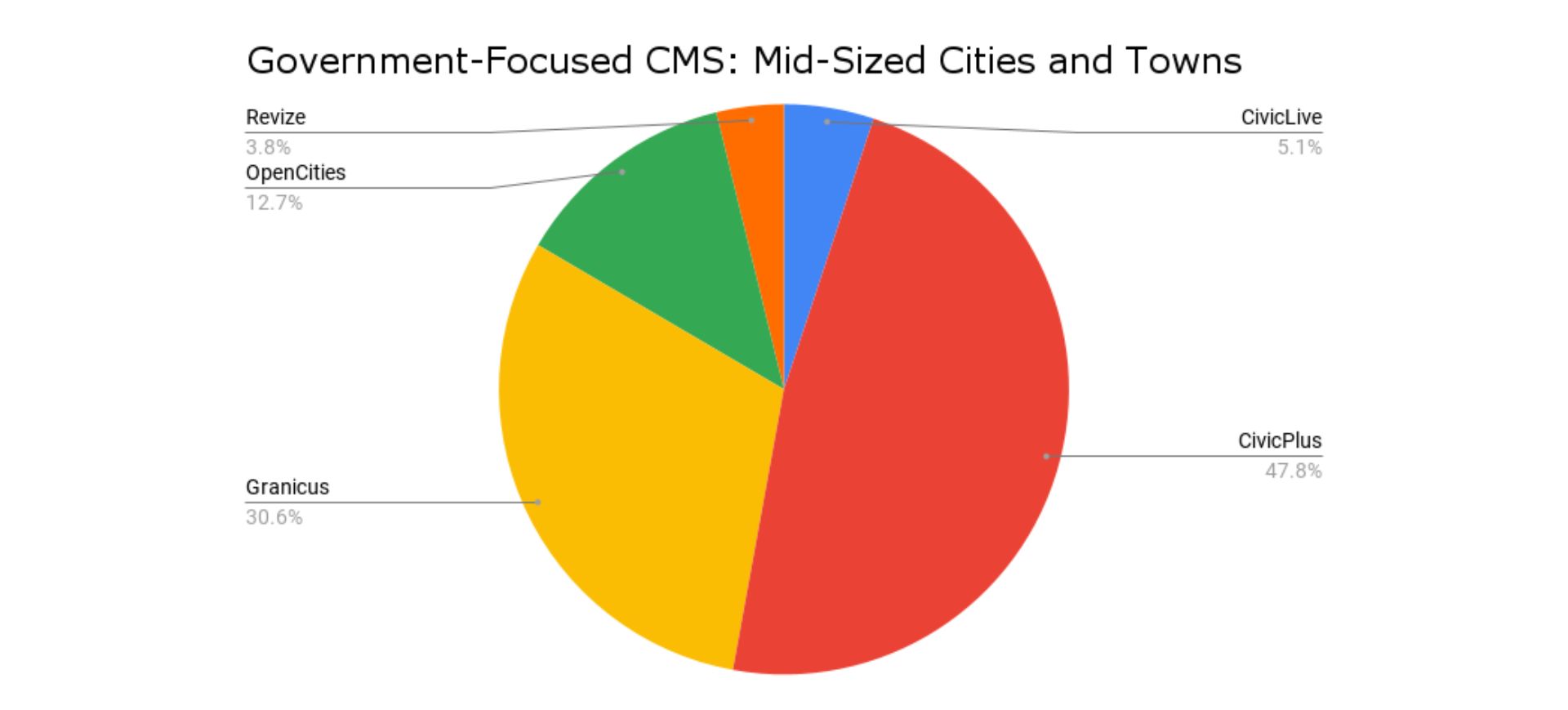
CMS platform preferences of large cities and towns
Now we’re looking at large cities and towns. What I find interesting is once again, we have the same CMS platforms dominating the scene:
- Drupal and Microsoft SharePoint are both at 22.2%.
- WordPress and DNN are both at 11.1%.
It is worth noting as well that both Adobe Experience Manager and Sitecore are missing here.
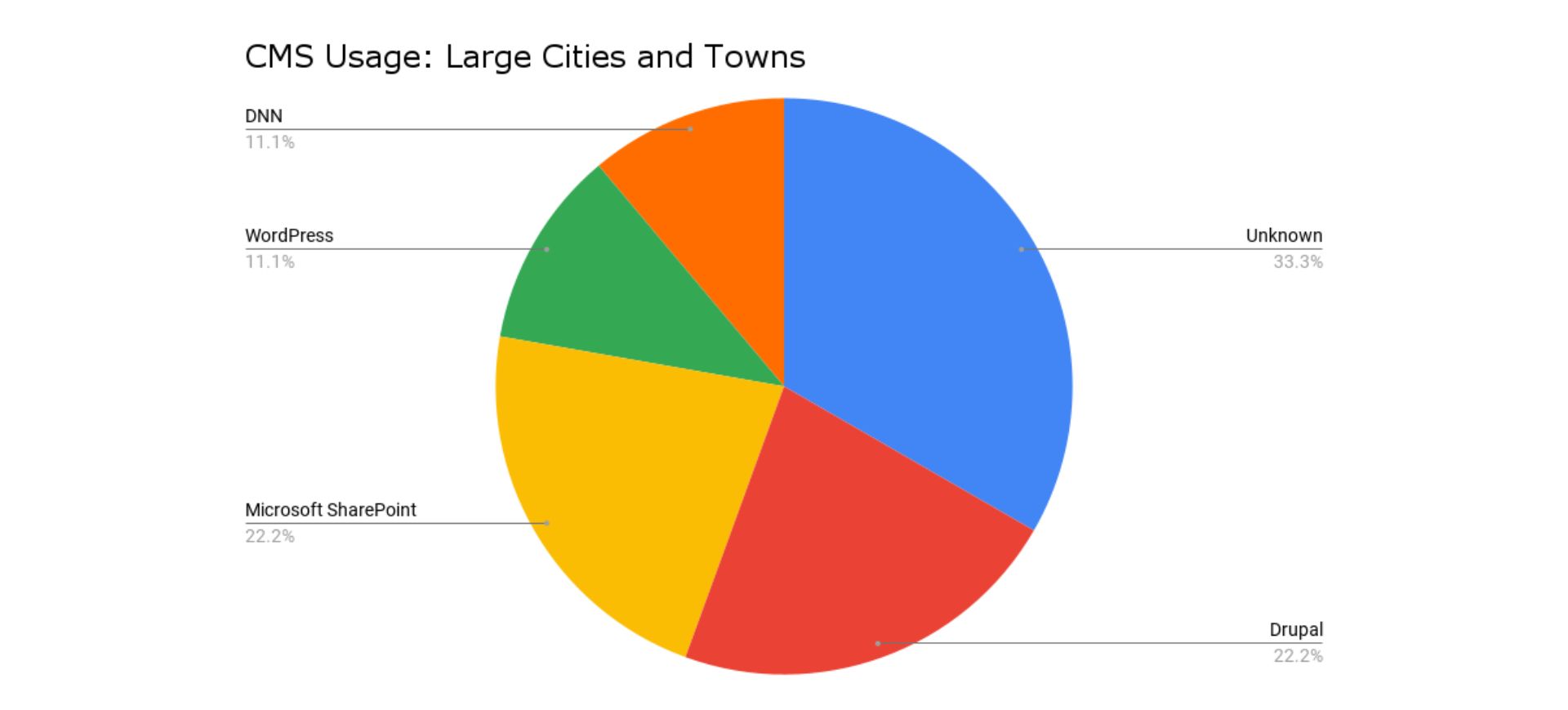
Right from the get-go, we can see that all the government-focused CMS solutions have disappeared.
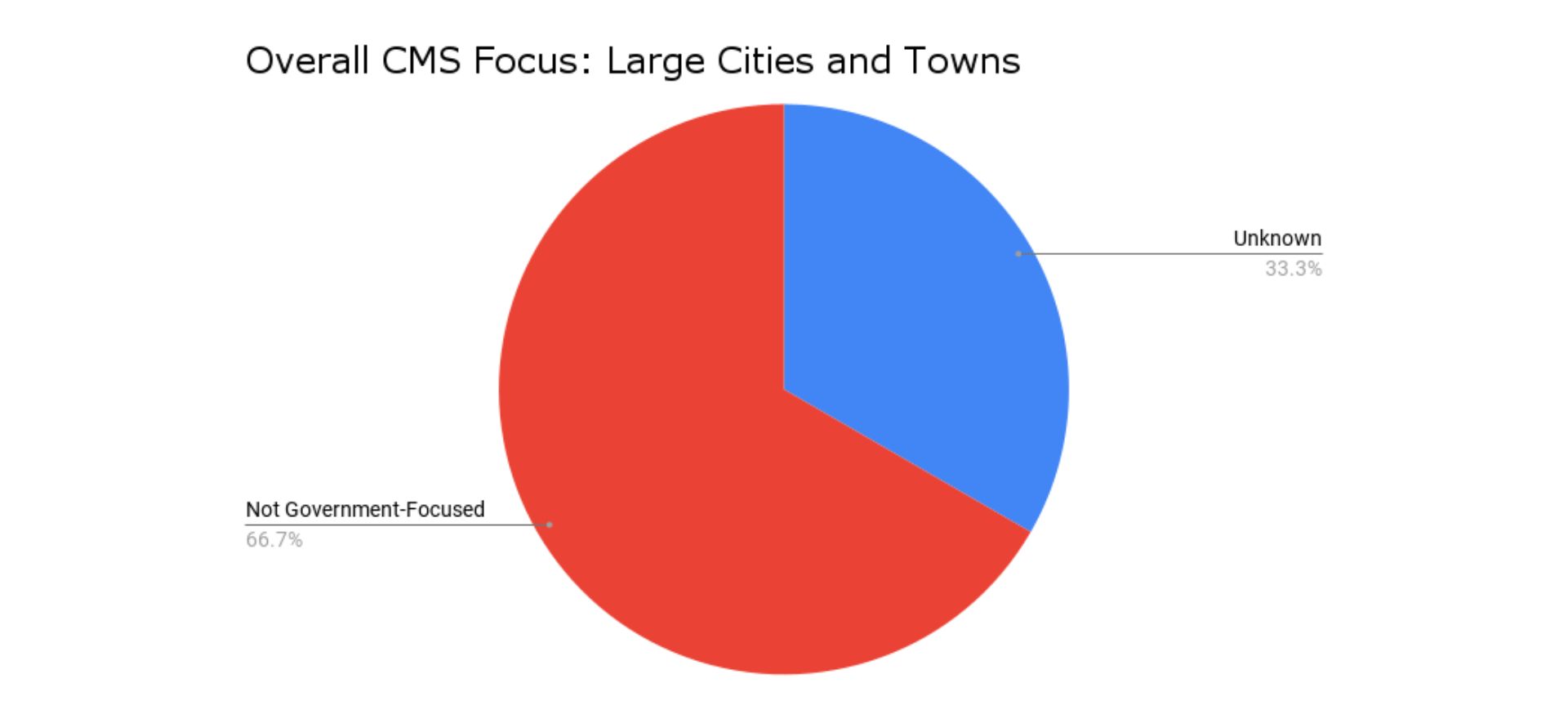
And that these remaining CMS platforms are all enterprise-level. Interestingly enough, we also see the same percentages for our large counties.
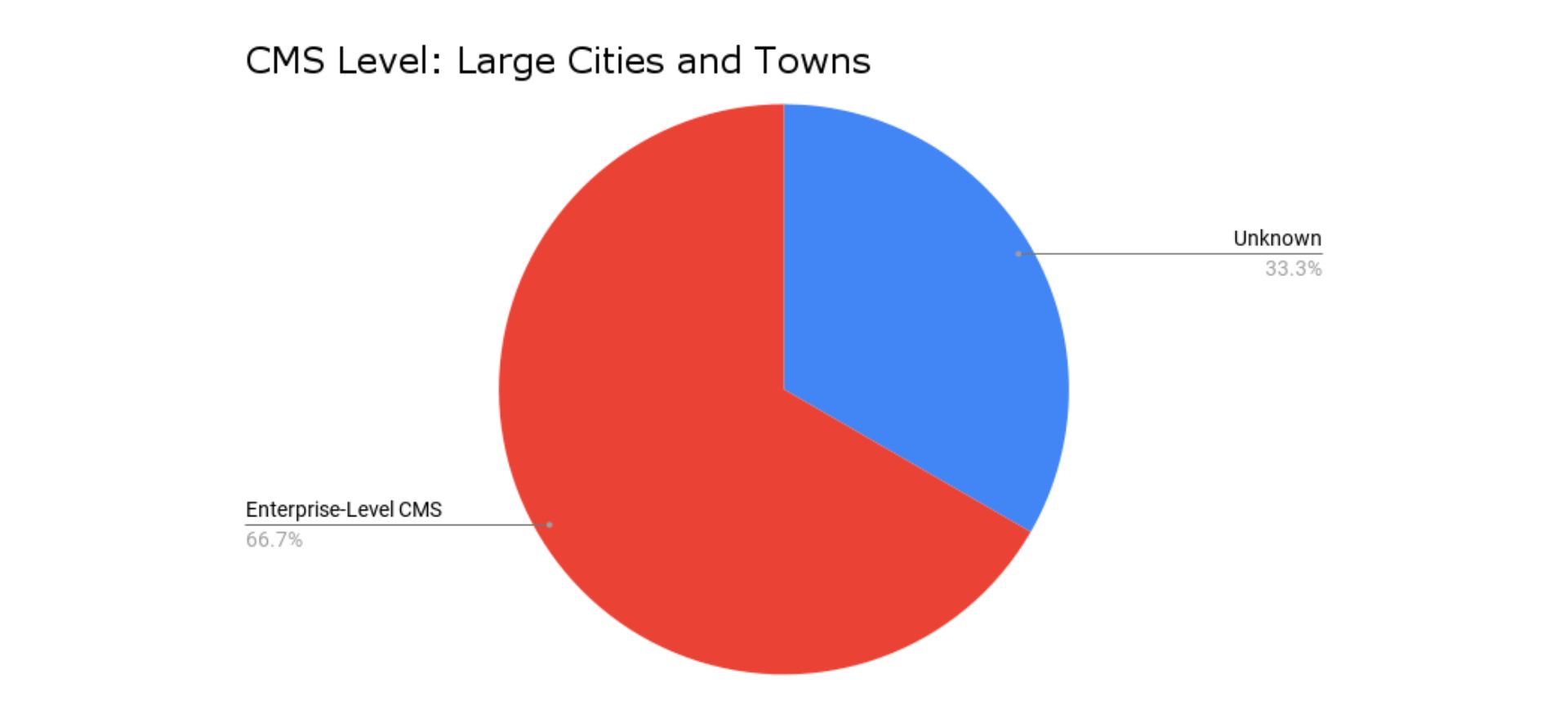
Overall analysis of CMS preferences by population
Looking at the data reveals a clear trend in CMS preferences as government entity size increases:
- Small to mid-sized entities heavily favor government-specific proprietary solutions.
- As the population grows, we see CMS adoption slowly shift towards enterprise-level CMS platforms, both open-source and proprietary.
- Large entities completely abandon government-specific CMS solutions in favor of enterprise systems.
This trend suggests that:
- Smaller local governments prioritize out-of-the-box features tailored to their needs.
- Increasing populations require more complex website requirements, which necessitate more scalable and flexible solutions.
- Larger organizations need enterprise-level CMS platforms to manage high traffic volumes, complex content structures, and integration needs.
The transition from government-specific to enterprise solutions as population increases indicates that:
- Government-specific CMS platforms may struggle to meet the scalability and complexity demands of larger entities.
- Enterprise-level CMS solutions offer the necessary flexibility, customization, and scalability for managing websites serving millions of citizens.
What is enterprise-level CMS?
As the population grows, we see a shift toward enterprise-level CMS platforms. One question I see is if there’s a difference between enterprise-level CMS vs open-source solutions.
The answer is no. Enterprise-level CMS, whether open-source like Drupal or proprietary solutions like Adobe Experience Manager, offers enhanced scalability and customization. That means they're better equipped to handle complex content structures, high traffic volumes, and integration needs common in larger entities.
Drupal, an open-source powerhouse, exemplifies enterprise-level capabilities. Case in point: Orange County, California, is the sixth-largest U.S. county with a population of over 3 million. We migrated their massive website—composed of 41 microsites—from a proprietary system to Drupal.
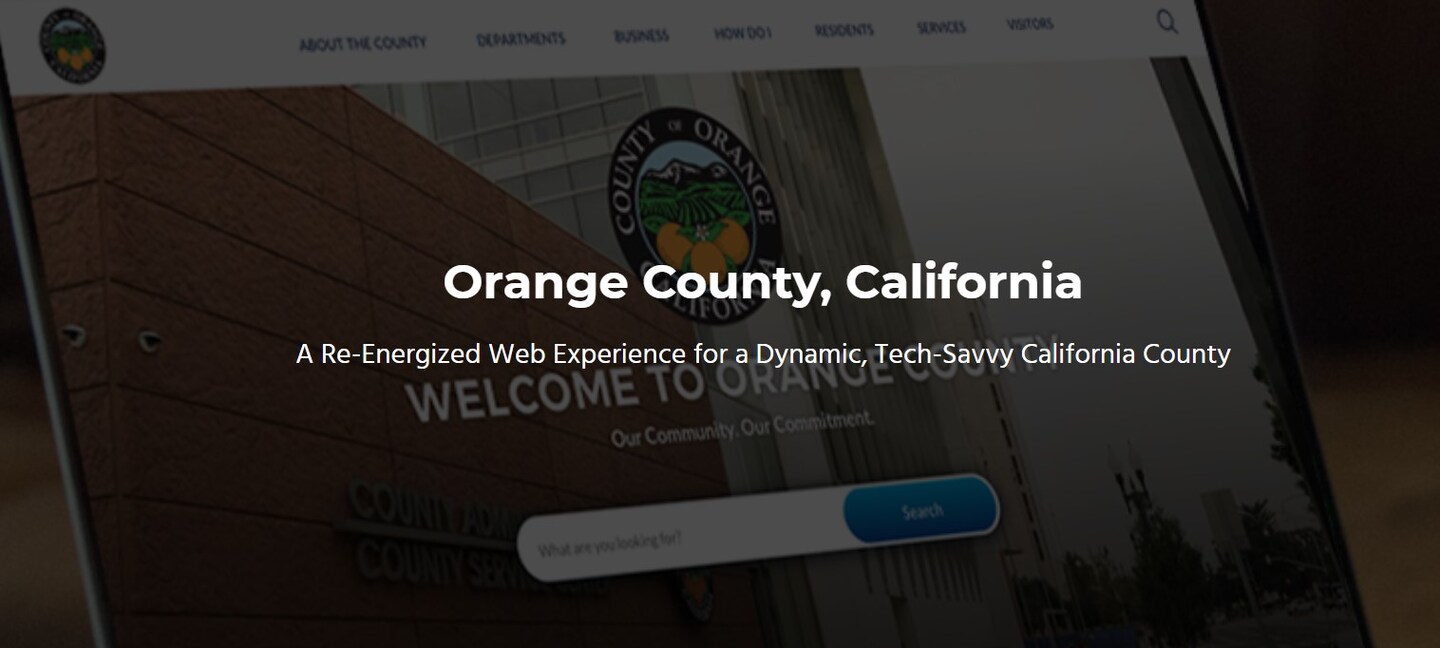
This project showcases Drupal's enterprise-level prowess:
- Unified 41 microsites with distinct owners.
- Maintained consistent UI, navigation, and UX across sites and devices.
- Scaled to serve a population of 3 million+.
This case demonstrates why enterprise-level CMS solutions like Drupal are essential for large government entities. By sticking to more specialized CMS platforms, flexibility and scalability become issues, and costs get prohibitive.
We now have the advantage of an Open Source CMS that is aligned with the worldwide Drupal Community. The result is big benefits. Taking all factors into account, we estimate that the annual cost savings will exceed $100,000.
—Quazi Hashmi, Program Manager, County of Orange, California
Why does enterprise CMS sound like asset management?
Enterprise CMS platforms often incorporate asset management features to handle documents, images, videos, and other digital assets along with regular web content. However, they're primarily focused on managing and delivering content for web experiences.
Digital Asset Management (DAM) systems, on the other hand, are specifically designed for organizing, storing, and retrieving rich media and digital files across an organization. An example of this is Acquia DAM (which we created a WordPress plugin for).
Drivers for enterprise CMS adoption
Now that we've seen how CMS preferences shift as government entities grow, let's look into the common reasons why larger entities gravitate towards enterprise-level CMS platforms. We have two county clients our Drupal developers migrated from a proprietary system to an enterprise-level CMS: Orange County, California (which we talked about in the previous section) and Martin County, Florida.

Here are the top reasons they migrated to Drupal—an open-source, enterprise-level platform.
Scalability and performance
As population size increases, so does website traffic. Enterprise CMS solutions like Drupal, WordPress, and Adobe Experience Manager are built to handle high volumes of visitors without breaking a sweat.
Remember Orange County's CMS migration to Drupal? That's 3 million+ potential users.
The site should not break from that weight.
Complex content structures
From our experience working with various State and local governments, we’ve found that larger governments deal with more departments, services, and information.
Enterprise CMS platforms offer robust content governance and management capabilities. They can handle intricate relationships between different types of content, making it easier for web managers to organize and present complex information.
This is something the government-specialized CMS platforms might struggle with as complexity increases.
Customization and flexibility
While out-of-the-box government platforms work great for smaller entities, larger governments often need more tailored approaches.
Enterprise CMS solutions offer extensive customization options. For instance, Drupal's modular architecture allows for endless possibilities in terms of functionality and design—especially coupled with Provus®, the platform we built and use to ensure content editors of Drupal sites won’t have trouble building and updating pages.
Integration capabilities
Large government entities often need their website to integrate well with other systems such as payment gateways, GIS mapping, or citizen engagement tools. Enterprise CMS platforms typically offer robust APIs and integration capabilities to handle these complex requirements.
Security and compliance
Based on the AEM vs Drupal comparison, enterprise CMS platforms take extra precautions as one of their top priorities.
Enterprise CMS solutions often have more advanced security features and are better equipped to meet stringent compliance requirements that larger government entities face.
Multi-site management
Remember how Orange County consolidated 41 microsites? That's a common need for larger governments. Enterprise CMS platforms like Drupal excel at managing multiple sites from a single codebase, maintaining consistency while allowing for customization where needed.
Cost-effectiveness at scale
This is where we argue open-source solutions shine. Remember, open-source CMS platforms are completely free, so you can choose both the platform and the vendor that works best for your budget.
On the other hand, proprietary solutions entail vendor lock-in. That means even if you get terrible service or your website isn’t performing well, you have no choice but to stick with them because they own both the platform and support.
Read: Open Source vs Proprietary for Government Websites →
Community and support
Another reason why we strongly advocate for open-source solutions is that open-source platforms like Drupal come with large, involved communities actively working to make the platforms better. This means a wealth of resources and modules to extend functionality, and of course, help.
It's worth noting that these drivers often interconnect. The need for scalability might lead to adopting an enterprise CMS, which then opens up new possibilities for customization and integration, further justifying the switch.
Bringing what’s new and next to the public sector
At Promet Source, we're committed to bringing cutting-edge solutions to the public sector. As we've seen in our analysis of local government entities serving from less than 100,000 residents to greater than 1.5 million, the evolution of government websites mirrors the growth of the communities they serve.
We're not just talking about making bigger websites to accommodate growing population needs—we're looking at real, impactful solutions that can flex and grow with the community's needs to serve them better.
Remember Orange County? That's not just a bigger website—it's a more capable, more flexible, and frankly, more future-proof platform. It's a fact that citizens are increasingly preferring to interact with their governments online, so governments have to keep up.
Looking to migrate your website to an open-source, enterprise CMS like Drupal? We’re here to work with you.
Get our newsletter
Get weekly Drupal and AI technology advancement news, pro tips, ideas, insights, and more.



